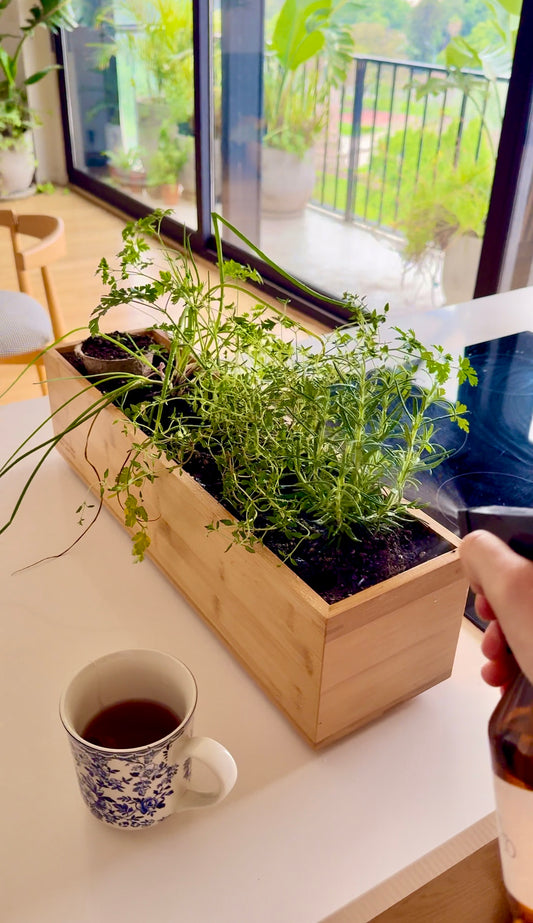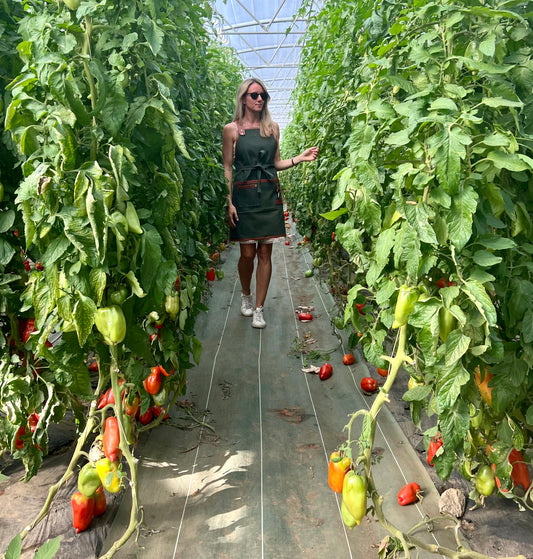At Fleur Du Bien, we believe that cooking should be a delightful experience filled with fresh flavors and aromatic herbs. That's why we've curated an exquisite indoor herb garden seed kit, featuring an array of culinary herbs like parsley, basil, thyme, chives, cilantro, and rosemary. Recently featured in Vogue, our kit is perfect for those looking to elevate their cooking or find the perfect gift for Christmas, housewarming, or holidays.
Why Grow Your Own Herbs?
Growing your own herbs brings an abundance of benefits that go beyond just flavor. Here are some compelling reasons to cultivate your own indoor herb garden. Here are a few reasons why having a sustainable indoor herb garden is worth considering:
-
-
Fresh, Organic Herbs Anytime: Growing herbs indoors ensures you have access to fresh, pesticide-free ingredients all year round. There’s nothing like harvesting basil, thyme, or rosemary directly from your kitchen for a dish, adding vibrant flavors and aromas to your meals.
-
Sustainable Living: An indoor herb planter kit is an eco-friendly way to grow your own herbs, cutting down on plastic packaging and food miles associated with store-bought herbs. With a focus on sustainability, you can use organic soil, compostable containers, and even reusable planters to create a low-impact garden at home.
-
Boosts Mental Well-being: Greenery in the home has been shown to reduce stress and increase feelings of calm and happiness. Caring for plants can also be a relaxing, mindful activity, adding a therapeutic element to daily life. Plus, the color green is often associated with renewal and relaxation, which can have a positive impact on mood and focus.
-
Adds Aesthetic Value: Beyond functionality, an indoor herb garden adds natural beauty to your space. Whether in sleek pots or rustic containers, herbs provide a fresh and charming look, enhancing kitchen decor and making the space more inviting.
-
Educational for All Ages: Growing an indoor herb kit is a hands-on way to learn about plant life cycles and sustainable gardening practices. It’s a wonderful activity for kids and adults alike, teaching patience and responsibility as you nurture and watch your plants grow.
-
1. Parsley
Culinary Uses
- Flavor and Garnish: Parsley has a fresh, slightly peppery taste that complements various dishes. It’s commonly used to garnish soups, salads, meats, and pasta.
- Ingredient in Sauces: It’s essential in classic sauces like chimichurri, tabbouleh, and pesto (especially the Italian variant).
- Balancing Strong Flavors: Its mild bitterness and fresh taste help balance richer ingredients like garlic, cream, or cheese.
Suggested Photo: A vibrant dish garnished with fresh parsley, showcasing its culinary use.
Nutritional Benefits
- Rich in Vitamins and Minerals: Parsley is a great source of vitamins A, C, and K, as well as folate and iron, which support immune function, eye health, and blood clotting.
- Antioxidants: It contains antioxidants like flavonoids, which help combat oxidative stress in the body.
- Low Calorie: It’s very low in calories, making it an excellent addition to any meal without adding extra calories.
Suggested Photo: A close-up of parsley with nutritional information overlay.
Health Benefits
- Supports Digestion: Parsley can aid in digestion and reduce bloating due to its mild diuretic properties.
- Anti-inflammatory: Its antioxidants and vitamin C may reduce inflammation, benefiting joints and reducing the risk of chronic diseases.
- Bone Health: The high vitamin K content in parsley is beneficial for bone health as it aids calcium absorption.
- Freshens Breath: Parsley’s natural chlorophyll can help neutralize bad breath.
Suggested Photo: An image of a glass of parsley juice or parsley tea.
Uses Beyond Cooking
- Herbal Tea: Parsley tea is thought to help with digestion, reduce water retention, and provide a mild detox effect.
- Skin and Hair Care: Due to its vitamin C and antioxidant content, parsley is sometimes used in DIY skincare routines to support skin brightness and health.
Suggested Photo: A DIY skincare product featuring parsley.
Gardening and Companion Planting
- Pollinator-Friendly: Parsley flowers attract beneficial insects like bees, helping to pollinate the garden.
- Companion Planting: It can be planted with tomatoes, carrots, and other crops to enhance their flavor and repel pests.
Suggested Photo: A garden with parsley growing alongside other vegetables.
2. Basil
Culinary Uses
Basil is a beloved herb, especially in Mediterranean cuisine. It’s the key ingredient in pesto and pairs beautifully with tomatoes, making it a staple in salads, pasta, and sauces.
Suggested Photo: A fresh basil pesto dish.
Nutritional Benefits
Basil is rich in vitamins A, K, and C and contains essential oils that possess anti-inflammatory and antibacterial properties.
Suggested Photo: Nutritional chart featuring basil’s benefits.
Health Benefits
Basil may help reduce stress, improve digestion, and provide anti-inflammatory effects.
Suggested Photo: A calming scene featuring basil plants.
3. Thyme
Culinary Uses
Thyme adds depth to soups, stews, and roasted meats. Its earthy flavor enhances dishes without overpowering them.
Suggested Photo: A dish of roasted vegetables seasoned with thyme.
Nutritional Benefits
Thyme is packed with vitamins C and A, as well as iron, manganese, and other essential nutrients.
Suggested Photo: Close-up of thyme leaves with nutritional details.
Health Benefits
Thyme has antimicrobial properties and may support respiratory health.
Suggested Photo: Herbal remedy preparation with thyme.
4. Chives
Culinary Uses
Chives add a mild onion flavor to dishes, perfect for salads, dips, and as a garnish on baked potatoes.
Suggested Photo: A colorful salad topped with fresh chives.
Nutritional Benefits
Chives are a good source of vitamins A and K, as well as antioxidants that combat inflammation.
Suggested Photo: Chives in a garden setting.
Health Benefits
Chives may promote heart health and have antibacterial properties.
Suggested Photo: A health-themed graphic with chive benefits.
5. Cilantro
Culinary Uses
Cilantro is crucial in many Latin and Asian dishes, bringing a fresh flavor to salsas, curries, and salads.
Suggested Photo: A vibrant salsa featuring fresh cilantro.
Nutritional Benefits
Cilantro is rich in vitamins K and C, and it’s known for its detoxifying properties.
Suggested Photo: Nutritional infographic featuring cilantro.
Health Benefits
Cilantro may help reduce anxiety and promote digestive health.
Suggested Photo: A relaxing kitchen scene with cilantro.
6. Rosemary
Culinary Uses
Rosemary is excellent for roasting meats and vegetables, imparting a robust flavor that enhances dishes significantly.
Suggested Photo: A rustic dish with rosemary sprigs.
Nutritional Benefits
Rosemary contains antioxidants and compounds that may support digestion.
Suggested Photo: A rosemary plant in bloom.
Health Benefits
Rosemary may enhance memory and concentration.
Suggested Photo: A study or workspace with rosemary nearby.
How to Successfully Sprout Your Herbs
-
Select Quality Seeds: Our herb garden seed kit contains premium seeds that are more likely to sprout successfully.
-
Prepare Your Containers: Use pots with drainage holes and fill them with quality potting mix. Make sure the soil is moist but not waterlogged.
-
Planting Depth: Follow the instructions on the seed packet for planting depth. Generally, seeds should be covered with soil to about two times their size.
-
Provide Adequate Light: Place your herb pots in a sunny location or under grow lights. Herbs generally need at least 6-8 hours of light per day to thrive.
-
Watering: Keep the soil consistently moist, but avoid overwatering. Water gently to avoid displacing the seeds.
-
Temperature and Humidity: Most herbs prefer warm temperatures (65-75°F). A humidity dome can help retain moisture until the seeds germinate.
-
Thinning: Once seedlings have a few leaves, thin them out to prevent overcrowding, allowing the strongest plants to grow.
Suggested Photo: A step-by-step image guide showcasing successful sprouting of herbs.
The Longevity of Your Herb Garden Kit
Using the Fleur Du Bien Indoor Herb Garden Seed Kit allows you to cultivate herbs that can be used for cooking for a long time. Here’s how:
- Continuous Harvest: By regularly trimming your herbs, you encourage new growth, allowing for a continuous supply of fresh herbs throughout the seasons.
- Regrowth: Many herbs, like basil and parsley, will keep growing if harvested correctly, meaning you can enjoy them for months or even years.
- Ease of Use: The kit is designed with user-friendly instructions, ensuring that even beginners can successfully grow and maintain their herb garden.
More Than Just a Kit: A Sustainable Choice
Our herb garden seed kit isn’t just a temporary solution; it’s a long-term investment in your kitchen and the environment. Here's how it can lower your carbon footprint and save you money:
- Reduce Plastic Waste: By growing your own herbs, you eliminate the need for plastic packaging typically used for store-bought herbs.
- Lower Carbon Footprint: Homegrown herbs require no transportation, significantly reducing your carbon emissions compared to buying herbs that have traveled long distances.
- Cost-Effective: Growing your own herbs is much cheaper in the long run compared to constantly purchasing fresh herbs from the store.
Suggested Photo: A visual comparison of store-bought herbs in plastic packaging versus homegrown herbs.
Perfect for Gifting
The Fleur Du Bien Indoor Herb Garden Seed Kit makes a thoughtful gift for anyone who loves cooking, gardening, or simply enjoying the beauty of nature indoors. It's an ideal present for:
- Christmas: Surprise your loved ones with a gift that keeps on giving.
- Housewarming: Help new homeowners settle in with their own fresh herb garden.
- Holidays: Show appreciation to friends and family with a unique and practical gift.
Suggested Photo: A beautifully wrapped gift box containing the herb garden seed kit.




